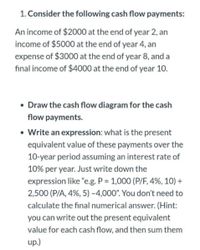
Essentials Of Investments
11th Edition
ISBN: 9781260013924
Author: Bodie, Zvi, Kane, Alex, MARCUS, Alan J.
Publisher: Mcgraw-hill Education,
expand_more
expand_more
format_list_bulleted
Concept explainers
Question
thumb_up100%

Transcribed Image Text:1. Consider the following cash flow payments:
An income of $2000 at the end of year 2, an
income of $5000 at the end of year 4, an
expense of $3000 at the end of year 8, and a
final income of $4000 at the end of year 10.
• Draw the cash flow diagram for the cash
flow payments.
• Write an expression: what is the present
equivalent value of these payments over the
10-year period assuming an interest rate of
10% per year.. Just write down the
expression like "e.g. P = 1,000 (P/F, 4%, 10) +
2,500 (P/A, 4%, 5) -4,000". You don't need to
calculate the final numerical answer. (Hint:
you can write out the present equivalent
value for each cash flow, and then sum them
up.)
Expert Solution
This question has been solved!
Explore an expertly crafted, step-by-step solution for a thorough understanding of key concepts.
This is a popular solution
Trending nowThis is a popular solution!
Step by stepSolved in 3 steps with 1 images

Knowledge Booster
Learn more about
Need a deep-dive on the concept behind this application? Look no further. Learn more about this topic, finance and related others by exploring similar questions and additional content below.Similar questions
- Assume the appropriate discount rate for the following cash flows is 10.3 percent. Year Cash Flow 1 $2,150 2,050 234 1,750 1,550 What is the present value of the cash flows? (Do not round intermediate calculations and round your answer to 2 decimal places, e.g., 32.16.) Present valuearrow_forwardPresent value For the case shown in the following table, calculate the present value of the cash flow, discounting at the rate given and assuming that the cash flow is received at the end of the period noted. (Click on the icon here in order to copy the contents of the data table below into a spreadsheet.) The present value is $. (Round to the nearest cent.) Single cash flow $91,000 Discount rate 15% C End of period (years) 25arrow_forwardUsing the future values tables, solve the following: What is the future value on December 31, Year 11, of 20 cash flows of $15,000 with the first cash payment made on December 31, Year 1, and the annual interest rate of 10% being compounded semiannually?arrow_forward
- What is the present value of the following stream of cash flows if the discount rate is 9%? Year 1-5: $14,000 inflow Years 6-20: $23,000 inflow (Use the present value tables in your course packet for any present value calculations. Round your final answer to the nearest dollar.)arrow_forwardSingle Cash Flow Present Value Inputs Single Cash Flow $1,000 Discount Rate/Period 6% Number of Periods 5 Present Value using a Time Line Period 1 2 3 4 Cash Flows Present Value of Each Cash Flow Present Value Present Value using the Formula Present Value Present Value using the PV Function Present Valuearrow_forwardDerive an equation to find the end-of-year future sum F that is equivalent to a series of n beginning-of-year payments B at interest rate i. Then use the equation to determine the future sum F equivalent to six B payments of $100 at 8% interest.arrow_forward
- Can you please confirm my calculations: discount rate is 6%; end of year cash flows are as follows: Year 0: -20,000; year 1 through 5 are each 5,000; is the net present value of all cash flows 1061.82? and how do you calculate "at what discount rate is the net present value "0"?arrow_forwardd. Determine the minimum annual net cash flow necessary to generate a positive net present value, assuming a desired rate of return of 12%. Round to the nearest dollar.Annual Net Cash Flow fill in the blank 1 of 1$arrow_forwardCash Flow Series B Cash Flow Series C -$2,330 $2,870 $2,470 $2,070 $1,670 $1,270 Y Y Y - 2Y 2Y 2Yarrow_forward
arrow_back_ios
SEE MORE QUESTIONS
arrow_forward_ios
Recommended textbooks for you
 Essentials Of InvestmentsFinanceISBN:9781260013924Author:Bodie, Zvi, Kane, Alex, MARCUS, Alan J.Publisher:Mcgraw-hill Education,
Essentials Of InvestmentsFinanceISBN:9781260013924Author:Bodie, Zvi, Kane, Alex, MARCUS, Alan J.Publisher:Mcgraw-hill Education,

 Foundations Of FinanceFinanceISBN:9780134897264Author:KEOWN, Arthur J., Martin, John D., PETTY, J. WilliamPublisher:Pearson,
Foundations Of FinanceFinanceISBN:9780134897264Author:KEOWN, Arthur J., Martin, John D., PETTY, J. WilliamPublisher:Pearson, Fundamentals of Financial Management (MindTap Cou...FinanceISBN:9781337395250Author:Eugene F. Brigham, Joel F. HoustonPublisher:Cengage Learning
Fundamentals of Financial Management (MindTap Cou...FinanceISBN:9781337395250Author:Eugene F. Brigham, Joel F. HoustonPublisher:Cengage Learning Corporate Finance (The Mcgraw-hill/Irwin Series i...FinanceISBN:9780077861759Author:Stephen A. Ross Franco Modigliani Professor of Financial Economics Professor, Randolph W Westerfield Robert R. Dockson Deans Chair in Bus. Admin., Jeffrey Jaffe, Bradford D Jordan ProfessorPublisher:McGraw-Hill Education
Corporate Finance (The Mcgraw-hill/Irwin Series i...FinanceISBN:9780077861759Author:Stephen A. Ross Franco Modigliani Professor of Financial Economics Professor, Randolph W Westerfield Robert R. Dockson Deans Chair in Bus. Admin., Jeffrey Jaffe, Bradford D Jordan ProfessorPublisher:McGraw-Hill Education

Essentials Of Investments
Finance
ISBN:9781260013924
Author:Bodie, Zvi, Kane, Alex, MARCUS, Alan J.
Publisher:Mcgraw-hill Education,



Foundations Of Finance
Finance
ISBN:9780134897264
Author:KEOWN, Arthur J., Martin, John D., PETTY, J. William
Publisher:Pearson,

Fundamentals of Financial Management (MindTap Cou...
Finance
ISBN:9781337395250
Author:Eugene F. Brigham, Joel F. Houston
Publisher:Cengage Learning

Corporate Finance (The Mcgraw-hill/Irwin Series i...
Finance
ISBN:9780077861759
Author:Stephen A. Ross Franco Modigliani Professor of Financial Economics Professor, Randolph W Westerfield Robert R. Dockson Deans Chair in Bus. Admin., Jeffrey Jaffe, Bradford D Jordan Professor
Publisher:McGraw-Hill Education